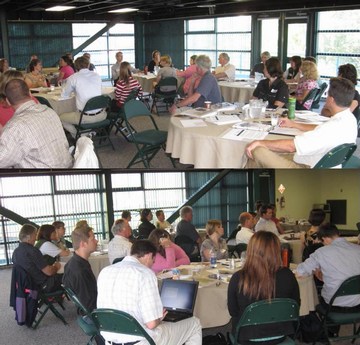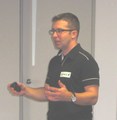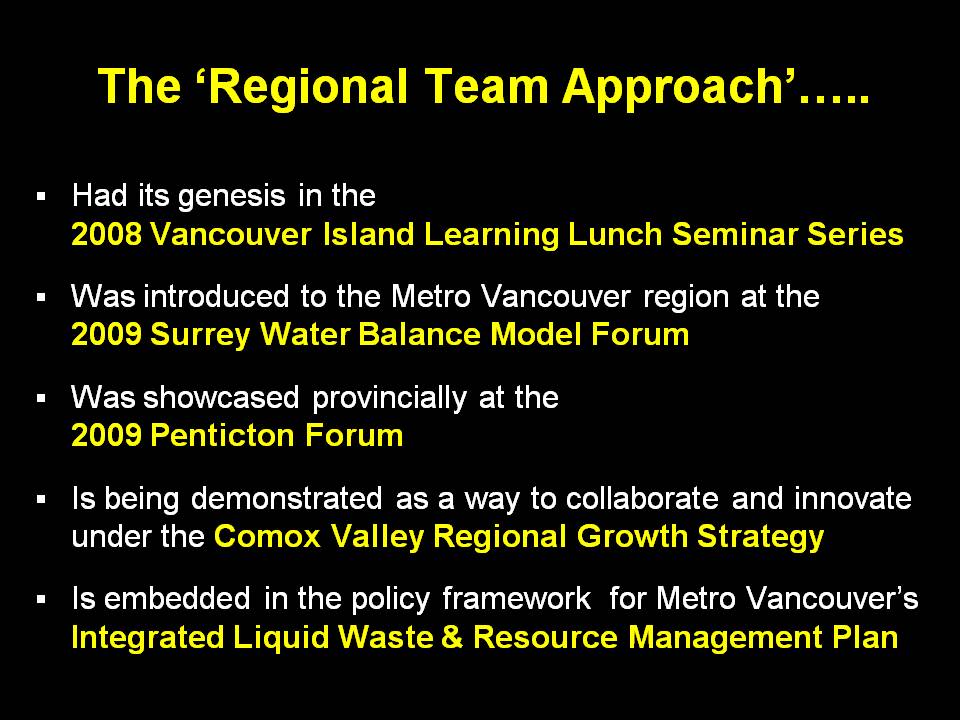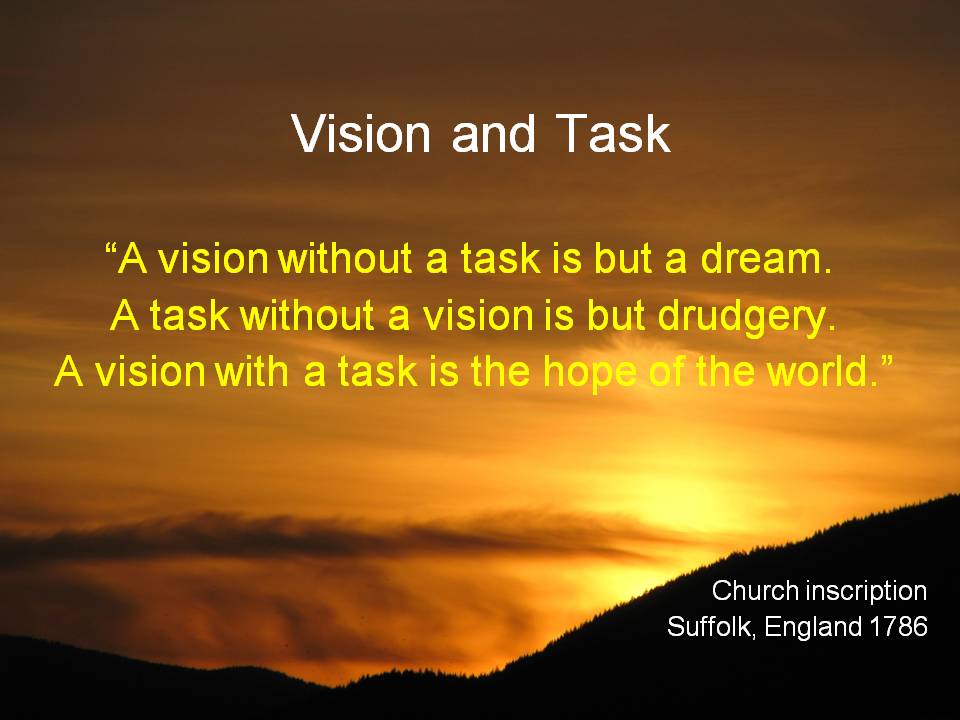Living Water Smart & Green Communities Initiative introduced to Southern Interior audience at Kamloops Workshop
Note to Reader:
In September 2009, the Kamloops chapter of the Planning Institute of BC (PIBC) and Canada Mortgage & Housing Corporation (CMHC) co-hosted a workshop that attracted planners from four regional districts in the Southern Interior, including: Thompson-Nicola Regional District, Central Okanagan Regional District, Regional District of Okanagan-Similkameen, and Columbia-Shuswap Regional District. The audience of approximately 40 also included muncipal representatives who travelled from as far afield as Revelstoke and Lake Country.

Big Ideas; Small Communities – Sustainable Planning and Development for Small Communities
“When it comes to planning and building for the future, small communities face their own unique challenges. CMHC’s comprehensive workshop, Sustainable Planning and Development for Small Communities, presents practical approaches to addressing long-term infrastructure needs,” states Lance Jacubec, CMHC Senior Consultant for Research and Information Transfer.
“The Kamloops workshop used the expertise of two featured speakers….Kim Stephens and Stephen Hall…. to discuss the topics of water management, housing, and community development through a lens that is appropriate to planners and administrators in both a municipal and regional context.”
Water Management – A Practitioner’s Perspective
The featured speaker on water was Kim Stephens, Program Coordinator for the Water Sustainability Action Plan for British Columbia, and an experienced engineer-planner with over 35 years experience related to infrastructure policy, master planning and project delivery.
 “The Kamloops Workshop was a great outreach and educational opportunity to spread the word to Interior communities regarding two provincial programs – Living Water Smart, BC’s Water Plan, and the Green Communities Initiative. As the Action Plan Coordinator, I spoke on behalf of two Ministries – Environment, and Community & Rural Development.”
“The Kamloops Workshop was a great outreach and educational opportunity to spread the word to Interior communities regarding two provincial programs – Living Water Smart, BC’s Water Plan, and the Green Communities Initiative. As the Action Plan Coordinator, I spoke on behalf of two Ministries – Environment, and Community & Rural Development.”
“My segment covered the best part of two hours, and turned into a town hall type of session. I had organized my material in three parts, with the first 10 minutes a fast-paced and high-level introduction to the ‘regional team approach’ to warm up the audience and set the tone for interaction.”
“After 10 minutes it was apparent that the audience was energized and engaged – the questions and comments were flowing thick and fast, and sharing of information was occurring spontaneously between participants. Next thing I knew an hour had passed, and we had not even started the second part of my presentation material. Fortunately, Lance Jacubec had allocated ample time to do everything. So the session worked out well.”
“Any time an engineer….even an engineer-planner…can connect with a group of planners, counts as a major accomplishment,” commented Lance Jacubec afterwards.
Living Water Smart & Building Greener Communities
“Living Water Smart, BC’s Water Plan and the Green Communities Initiative must be viewed as an integrated package. Living Water Smart presents the vision, and the Green Communities Initiative provides enabling tools to achieve the vision. Together they represent a call to action,” Kim Stephens told participants at the Kamloops Workshop.
Regional Team Approach
“A regional team approach is founded on partnerships and collaboration; and seeks to align actions at three scales – provincial, regional and local.The essence of the regional team approach is that all the players will set their sights on the common good and challenge the old barriers of jurisdictional interests.”
“The key word is alignment: this is what we want to collectively achieve, and this is how we will work together to get there,” emphasized Stephens.
Living Water Smart
The partnership umbrella provided by the Water Sustainability Action Plan has allowed the Province to leverage partnerships to greatly enhance the profile and resulting impact of Living Water Smart.
By choosing to live water smart, communities will be more prepared for climate change and their quality of life will be enhanced. If we can show how to get the water part right, then other parts are more likely to follow.
Leveraging Change
A mandate of the Ministry of Community & Rural Development is to foster partnerships, collaboration, innovation and integration through the program elements that comprise the Green Communities Initiative.
The Green Communities Initiative encompasses a number of plans and strategies that directly complement and/or support Living Water Smart outcomes.
About Kim Stephens
A graduate of the University of British Columbia in the 1970s, Kim Stephens has played a leadership role in a series of Provincial initiatives in British Columbia related to water sustainability, rainwater management, green infrastructure, and smart development.
- Member of the Working Group appointed by the Ministry of Environment in 1997 to develop A Water Conservation Strategy for British Columbia, released in 1998.
- Project manager and principal author of Stormwater Planning: A Guidebook for British Columbia, released in 2002, a guidance document that introduced a performance-based methodology for changing the way we develop land by designing with nature.
- Since 2003, the ‘virtual secretariat’ for the Water Sustainability Action Plan for British Columbia, which is the partnership umbrella for an array of on-the-ground initiatives that promote a water-centric approach to community planning and development.
- These partnerships include: the Water Sustainability Committee of the BC Water & Waste Association, the Water Balance Model Inter-Governmental Partnership, the WaterBucket Website Partnership, the Green Infrastructure Partnership, and the Convening for Action on Vancouver Island Partnership.
To download a copy of the PowerPoint slides that provided the backdrop for the Kamloops curriculum, click on Living Water Smart and Building Greener Communities: Implementing a regional team approach in BC.
Links to YouTube Video Clips:
A series of video clips is posted on YouTube so that viewers will have the flavour of these Action Plan messages:
Key Message #1: “The Province’s call to action” (4:09)
Key Message #2: “The mission is to create a legacy” (3:25)
Key Message #3: “What convening for action means” (2:44)
Key Message #4: “Why regional TEAM approach changes the paradigm” (5:51)
Key Message #5: “Vision and Task” (0:44)








